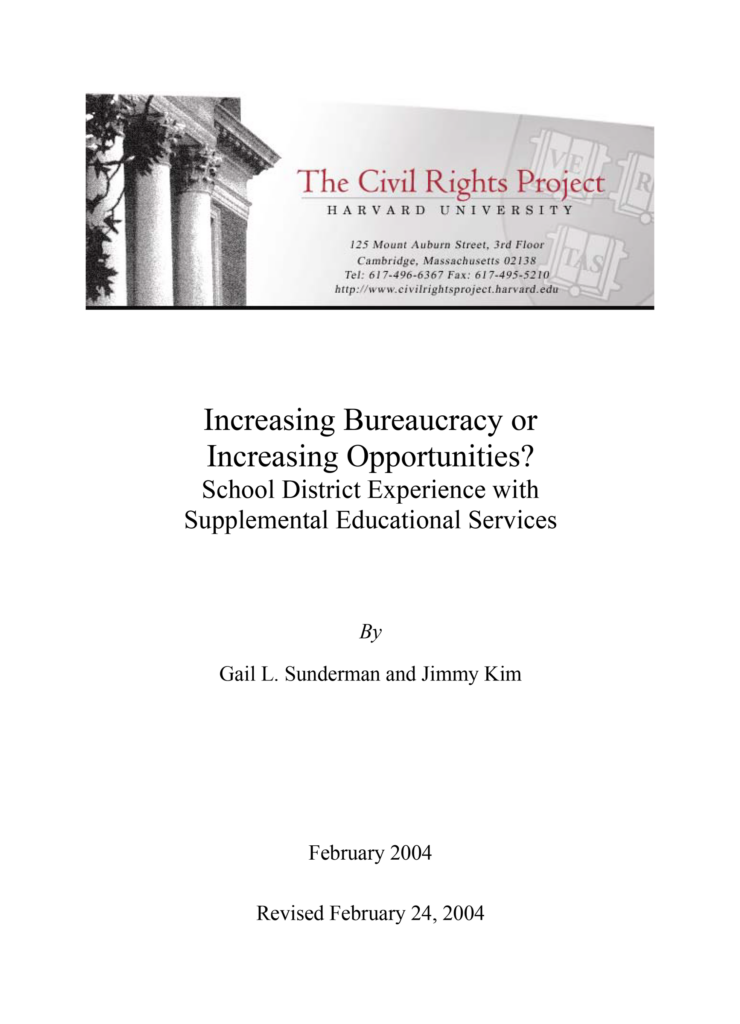EXECUTIVE SUMMARY
The No Child Left Behind Act (NCLB) requires districts to offer supplemental educational services to students in schools that are in the second year of school improvement—that is, schools that have been identified for not meeting the state’s adequate yearly progress goals for three consecutive years. NCLB defines supplemental educational services as “additional academic instruction designed to increase the academic achievement of students in low-performing schools” and states that services must “be provided outside the regular school day.” Supplemental service providers may include non-profit, for-profit, and faith-based organizations in addition to the public schools. These requirements are new and have no precedent in prior federal legislation.
This report examines the implementation of NCLB’s supplemental educational service provisions in eleven urban districts— Mesa Public Schools and Washington Elementary District Schools, AZ, Fresno Unified School District and Los Angeles Unified School District, CA, Chicago Public Schools, IL, Buffalo Public Schools and New York City Public Schools, NY, Arlington Public Schools and Richmond Public Schools, VA, and Atlanta Public Schools and DeKalb County Schools, GA. This geographically, politically, and demographically diverse sample of districts provides a range of local contexts for studying the implementation of supplemental educational services. Our first year study highlights the following findings.
Supplemental educational services were not widely used during the first year even though there were thousands of eligible students.
- In each of the districts we studied, fewer than 18% of eligible students requested and received supplemental educational services. In most of these districts it was less than 7% of the eligible students, and in some it was less than 1%.
- This provision disproportionately impacts districts serving large numbers of low income and minority students, yet there is little empirical evidence of its effectiveness for the most vulnerable students.
Supplemental educational services placed enormous administrative burdens on districts implementing supplemental education services.
- Districts provided considerable administrative and managerial oversight of the development and implementation of the program yet there no additional resources to meet these responsibilities. While Title I administrative funds could be used for this purpose, districts reallocated these from existing funds and programs.
- Title I schools also lost resources since districts reduced a school’s Title I allocation to cover the costs of supplemental services, diverting resources from other reform efforts. This funding strategy limited efforts to plan for long-term school reform.
- Most supplemental educational services programs were not well coordinated with the classroom curriculum and there were few mechanisms for providers to communicate effectively with classroom teachers.
Supplemental educational services are being implemented with little or no accountability.
- Few districts had plans in place to evaluate supplemental services, and those that did relied on the most rudimentary evaluation methods.
- There is no research on how these programs might work or how they might effect student achievement and the performance of Title I schools.
Even though supplemental services were not widely used during the first year, it remains important for the following reasons:
- Supplemental educational services represents a major tenant of the law, that is, that competition will produce better educational opportunities for disadvantaged students than the public schools provide and that accountability for individual student achievement will improve the performance of low performing schools. Whether this is true remains untested.
- The potential for supplemental educational services to fragment Title I is real and not addressed in the law. Supplemental services revises the direction of earlier Title I legislation that encouraged programs designed to increase curricular and instructional integration and diverts resources from the most needy schools.
- Supplemental educational services shift the focus from improving poorly performing schools to improving individual student achievement, but only for those requesting services. Combined with the loss of resources, it is unclear how this strategy will improve low performing, disadvantaged schools.
- The demand for supplemental educational services is likely to increase in most jurisdictions because the number of students eligible to receive services continues to grow and parents seem to prefer supplemental services over the option to transfer to another school.
While disadvantaged students can benefit from access to additional services, how they are provided is as important as their availability. Research suggests that stand-alone programs tend to fragment the delivery of instruction without any clear educational benefit. While there is no panacea to improving the performance of disadvantaged students, research has identified some directions that are more effective than others. For now, better evidence is needed before public dollars are used to support supplemental educational services on a large scale.
In compliance with the UC Open Access Policy, this report has been made available on eScholarship:
